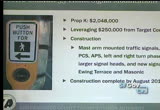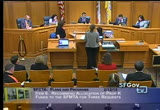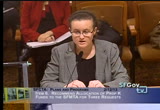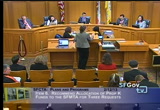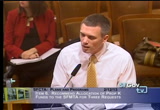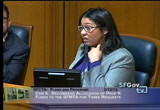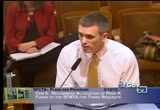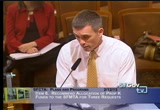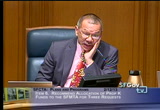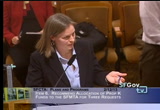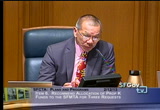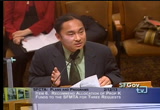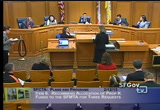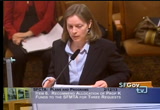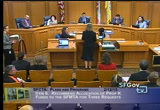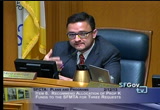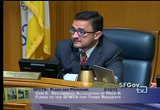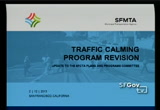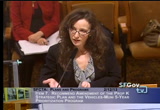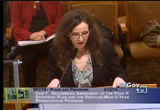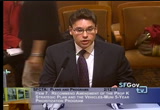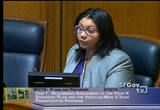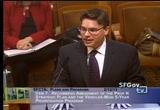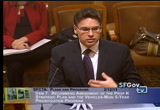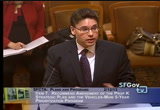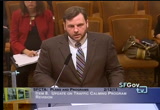tv [untitled] February 16, 2013 10:30am-11:00am PST
10:30 am
additional signal heads and finally a new traffic signal at moscone and masonic and you --. this prop k allocation supplemented from a target fund. the sfmta anticipates construction of all improvements will be completed in august 2014 and with that i can take any questions. i am aware of that sfmta managers are here as well. >> commissioner campos. >> thank you very much. i wanted to just ask a couple of questions. i think that these projects are very very important and i know that for a lot of neighborhoods, a lot of districts this is something that's going to improve the service. i was wondering if you could talk about the level of
10:31 am
coordination between the two agencies, between the ta and the mta. one of the discussions we had in the past is making sure that we have as much coordination as we possibly can, and that there is as much efficiency as possible, and i am just wondering if you can talk about, and also if you can talk about whether or not you anticipate any cost overruns in any of these expenditures and completeod time? >> for all of the projects? >> yes. >> i know they have coordinated to some extent, obviously on the [inaudible] fund projects to insure funds are available at the time they are needed. in terms of cost overruns that is something that i suspect our colleagues at sfmta have to
10:32 am
address but based on this the costs seem in alignment with costs we received previously so the expectation is that they should not occur. with that said i -- >> maybe we can hear from the interim executive director. >> of course. >> thank you. >> thank you. yes it's a big question there. i'm not used to seeing you here. so this is a good segue to an item later on the agenda and prepare for example the update of the prop k strategic plan and the five year prioritization program. that's the first place for us to coordinate with the mta and the other sponsors. without giving away too much of that presentation this body works with the sponsors to lay out the next five years of projects. in terms of delivering on time and on budget the most critical to watch is the n-judah customer first project. we helped partially fund a similar project on the [inaudible]. these are critical. it's really the
10:33 am
first wave of implementation. these are not subject to the eir. they're accomplishing many of the same things and once it's approved it will make changes to that as well and that is what we will report back to you and on performance benefits as well. >> thank you. i am sure supervisors -- when it comes to that it's a big priority. thank you. >> commissioner breed. >> thank you. i just had a few questions. so this -- i notice that there weren't -- this increases efficiency. do you have percentage wise in terms of what the results of the increased efficiency is as a result of this project? >> i believe our understanding is that these specific improvements will result in one minute travel time improvement and the transit effectiveness
10:34 am
project will contribute additional minutes on top of that. shawn kennedy is here from the sfmta. he is the project manager. if i could i would like to invite him up here so you're aware within the allocation request we have a deliverable to measure the before and after results after the improvements are implemented. >> sure. thank you. so yeah we're expecting a minute, a minute time savings or so with the customer first projects. they're really related towards enhancing the customer environment and making kind of our high quality frequent network more visible to the customer so we're seeing these as complementary trying to get off to the same objectives as tep but they're not those projects constructed, and yeah the minute time savings we have
10:35 am
a number of other projects within it being cleared right now environmentally for time travel reduction. >> commissioner, could i jump in. shawn, can you qualify how the one minute savings -- i know there is a dollar savings and how much is that worth? >> yeah, we haven't quantified the operational cost savings yet. there are a lot of factors going into our operational costs model, so we're still working on quantified exact number for that, but it will be substantial. >> i just think this is a lot of money for a one minute time saving and i i'm just not clear as to what type of difference this would make especially because it doesn't include additional trains or improvements to the trains. >> the capital stuff is within
10:36 am
the tep and that's why these projects are not in there. they're more for the customer experience and why it's customer first projects and colorize a lane helps enforcement and in that area and the only one that allows left turns and you're allowed to enter that and we see cars encroaching it and slowing down the trains and we hope that colorizing will cut down on the tactics by automobiles and improve the look and feel of the system and our high travel corridorred. >> how do you enjoy the look or feel if the train is over crowded or if you can't get on the train or there are empty
10:37 am
trains out of service and constantly passing you by and you're late to work. i am trying to understand. i am going by what i am experiencing and what the complaints that i am getting from the people who ride the n judah in my district and the continual problems in the peak times in the morning. it's a real problem and when i think how we spent money in the city and what we should be focused on i think about additional trains so people can get to work on time. >> sure. two points and one obviously fleet is good but under funding -- funding constraints. we need to better manage the system and one reason you see crowded trains and aside from number of cars that you see crowded trains is that their reliability takes a hit so you
10:38 am
get more bunched trains. you get off schedule and then you have a lot more people tried to crowd on one of the first trains and we hope with the first up and with the lanes and self enforcement can increase reliability and that is one way to enhance the customer experience. >> and you don't have like what this means in terms of dollar figure? >> no. we don't have that right now. >> okay. thank you. >> you bet. >> commissioner yee. >> thank you. this couple acronyms in here in the report because i am new i don't know what they mean, so one of them is pcs and the other is aps. can you plain that? >> absolutely. so these both refer in the signal projects
10:39 am
and that is pedestrian crossing and aps is accessible crossing and have the hearing impaired sounds. please don't hesitant to ask questions. this section is full of acronyms. >> if i want more information on a particular modification in terms of this contract and section improvements. it says one of them number nine, full upgrade at aps install one curb ramp. for me to understand it better is -- i couldn't find anything in the report. is there something else to look at to get more details? >> we have harvey quan can hear it. he's from the signal section from sfmta and happy to meet you with after or even better [inaudible] >> good morning commissioners.
10:40 am
through the chair, commissioner yee i think you're referring to intersection number nine which is circular monterey and one of the challenging ones in the city. the scope of the project there is basically remove all of the signal and for the people coming from monterey and we going to install a curb ramp at one of the corners where it's missing and install the signals for the hearing impaired. >> does this -- one of the issues on that corner or on that intersection is that there is a median on monterey boulevard,
10:41 am
and it's about 18 inches -- maybe 12 inches wide, so if one doesn't make it across and you're standing on a median and the traffic coming off the freeway they're going like 50 miles per hour, doesn't seem like a safe condition. is this going to be addressed? >> that is something we did look at. the median on monterey is pretty wide and it narrows down as you approach the intersection so it's a challenging location to do. as part of the project we will extend the signals for the time for pedestrians to cross at monterey boulevard. the crossing is not at 90-degrees. it's skewed and i understand the challenges but our project will extend the signal there to give pedestrians time to cross. >> but there is nothing you can do with the median itself? >> that is something we did
10:42 am
look at and we struggled to find a way to widen it. it's constrained location. we expanded one of the islandos the north side and made it larger so pedestrians have a better location to stand, but the median itself is challenging. it's a pretty narrow area i understand. >> well, i hope you folks will continue looking at that issue because it's -- i think what you need to do is stand there and you get a sense of what people have to deal with on that median. >> i would be happy to work with your office and explore further designos that. >> thank you. i know there are a couple more questions and i wanted to chime in that the staff really provide tremendous amounts of information that come to us, so i'm really appreciative of that. i really like the signal improvements, intersection improvements that impact my district, but also
10:43 am
commissioner breed's as well. the residents off of ewing and masonic and the target there are appreciative of the improvements there and i would like to thank target for the leveraging of the money as well. i know the scheduling opening is in the fall for that store and i hope the improvements are timed for some of those occurrences and thank you to all of you for being here as well. ms. lam bardo. >> if i might and commissioner yee's meetings and this might be your second meeting but your questions are spot on. we will address this later on talking about the needs assessment as part of the county update but in with respect to the n judah area and we have to deal with
10:44 am
significant crowding problems today and reliability issues with the transportation system but plans for significant growth in the future and it's a double whammy that not everyone has to deal with it. this is one of several projects we received funding from the metropolitan transportation commission. it's specific intended to grow ridership and reliability. i know the numbers seem strange but a minute savings is significant for this investment. we can come back to that later. commissioner breed. >> [inaudible] just so this for the grant received. it's specific to that. i am wondering why this and why not additional trains? and if this is to increase ridership if you have a crowded train, if people
10:45 am
can't get onto these trains during commuter hours i mean what is the point? >> i completely understand. we really in san francisco need a multi-pronged approach. this particular program at sfmta is designed to do low level for these improvements and we're making it more reliable and user friendly. >> the question i have -- the last question i have is in regard to the cameras. is there going to be tickets associated with those cameras that are just mailed to people for violations? >> commissioner, yeah, we have an existing 30 buzzes that have toll cameras on them and we have issued since 2009 10,000 citations with the cameras.
10:46 am
the idea is they can't ticket for moving violations. only if you're double parked in a transit only lane so it basically takes a picture of the car that is sitting there and gets the license plate and we mail that. >> okay. thank you. >> commissioner campos. >> thank you mr. chair. if i may add a couple of points to my colleagues. the way the process for funding these projects works under prop k is that the county transportation authority staff gets a request from the agency. in this case it's the muni, mta, and they make an assessment analysis whether or not their request is consistent with the goals and the objectives of prop k, and based on that analysis they make this recommendation. my suggestion would be to the mta given the questions that have been asked, which i think
10:47 am
are on point. it's useful going forward for the mta to sit down with the individual supervisors. we're asking to spend money on a particular project in a certain district and you sit down with the supervisor before you come to plans and programs because as supervisor breed rightly points out there's a question of is this really the best way to use these funds? we know that legally programmatically it's good to do that but in need to a specific neighborhood is this the best way to invest it? i think those are the kinds of questions that that we want to see in plans and programs, and i think having that discussion with the supervisor in advance would be very useful. >> thank you. so colleagues
10:48 am
let's open this up for public comment. is there anyone from the public that would like to speak on this item? seeing none public comment is closed. colleagues, is there a motion? >> so with the understanding with the hope going forward we will hear, have more of the communication i move this item forward with a positive recommendation. >> can we do this without objection colleagues? thank you. let's 1130 now. let's keep this meeting moving. >> item seven is recommendation of the prop k strategic plan. this is a action item. >> good morning. this is a fitting item to follow this last item. this is an amendment of the vehicles-muni 5-year prioritization program and
10:49 am
koar ponding amendment and i won't go over the five year plan because that is covered in a item later that maria is presenting. this is for a five year program of projects that the agencies will be implemententing and the plans need to be in place before allocations are made. in 2009 when the authority board adopted the five year plan for the vehicles category the plan was programming of $57 million over the five year period and the majority of the funds were anticipated to be needed in the first three years and for vehicle replacements and including para-transit vehicles and trolleys and other vehicles and some historic rehabilitation projects. for a variety of
10:50 am
reasons the procurement has been delayed, if you will, to the latter portion of the five year plan period, so these reasons include mta has recently updated its fleet plan and revised its fleet procurement strategy to incrementally refresh the fleet with staggered procurements. they have been coordinated with us for the other project and now that the locally preferred alternative has been selected this procurements are moving forward so all of this is to say that in the fall the board approved the programming, or the reprogramming of 40 million of the $57 million it left about $10 million left for programming. also in the fall the authority board allocated about $16 million for the procurement of about 60 40-foot
10:51 am
electric diesel hybrid coaches and these are important projects as far as transit performance and reliability. there is no substitute for getting new vehicles and replacing and refreshing the fleet. this is the second part of the amendment to program the remainder of the funds. this will align prop k funds and leveraging $210 million of federal funds that are anticipated to be available over the next two years. and they provide a local match. they released the capital transit priorities plan and this is in accordance with that. also -- although mta is pushing out when the vehicles are procured it's accelerating the timeline for procuring them. it's going to be done through a consortium through the state of minnesota and that's the intent
10:52 am
for the additional procurements coming up where mta participates in a larger contract and tailors the specks for san francisco needs but doesn't have to go through a longer process of coming up with the contract guidelines so this saves about a year for the procurement process. the impact of pushing out when the funds are needed but bringing when the funds are needed, if you will and pushing out the programming but accelerates the cash flow. it's essentially a strategic neutral plan amendment so it makes the cash available when mta will need it in order to secure these vehicles. i am here to answer any questions that you have. we also have mta staff here as well. >> thank you. i had one question. i know commissioner breed raised how crowded different lines are from the n
10:53 am
judah and a know of other lines are crowded and the plan is replace the 40 feet motor coaches and 60 foot buses and what are the plans? >>i know that is considered for the one project but i will let jonathan rivers address that. >> thank you. >> commissioners, to answer the question there is a service plan and our fleet plan and program that we have at the mta and it does call over the life of the fleet that we up scope to 60-foot motor coaches. the first is the van ness brt and that current line is replaced with 60-foot vehicles to deal
10:54 am
with crowding and other issues so as we have future procurements and replacing our fleets and the depending on the line it's intended to use for we may up scope. i know the long-term plan is increase the 60 feet vehicles in the plan and that is reflected in the fleet plan. >> thank you. commissioner breed. >>i just wanted to ask a quick follow up question to that. has mta looked into the possibility of increasing the size of the trains for the n judah? >> you mean increasing the physical size -- well, . >> well, first of all increasing the size and if new trains are purchased? >> to answer that question. right now we're in the process of scoping the replacement
10:55 am
vehicles that will replace them so we're in that process so we will look at the size of the vehicles and the number of seats in the vehicle. that is being worked on right now. that is in anticipation of purchasing 24 additional light rail vehicles for the central subway when it comes on line and that if for the vehicles that we'll need with that and deal with overall growth at this point in the overall muni network. on top of that we are looking at -- i believe the fleet plan calls if -- i am just guessing, 40 to 50 additional vehicles needed based on the overall growth of the city and deal with the crowding within the network. i know john hailey has been here a couple of times and for the new members just to tell you we don't have enough vehicles today. we have barely enough to meet our daily
10:56 am
service demands so he would tell you if he was here we brought two more on line and that is helping with the fleet and frequency and crowding but it's the overall plan and the plan calls for us to purchase more vehicles. >> thank you. >> thank you. commissioner campos. >> thank you mr. chair. just a quick question. whenever you make this kind of investment you want to make sure you have a maintenance plan in place so you project that investment and make sure it lasts as possible so if you can briefly talk about that please. >> yeah. so there are two ways i like to talk about maintenance especially when talking about the muni fleelt and one is regular maintenance of the vehicles to keep them functioning and working and clean for the public as it is used day to day, and the other is the component replacements that are necessary on the fleet. for example a light rail
10:57 am
vehicle needs to last 25 years and over the life of that vehicle major components like the trucks need to be replaced and we don't have the resources within the region to always do that. currently on the one fleet we have funds to do limited truck replacement because when the components fail the vehicles is out of service and sometimes a long-term period as we wait for the parts to come and that's why we don't always have the availability that we need. we are looking at in the five year capital improvement program and working with the committee to come up with long-term solutions how we pay for the midlife overhauls on the fleet which is what we call them and replace the major components and we can guarantee they meet the useful life and available for service. >> thank you. >> thank you. colleagues, if there is no other questions
10:58 am
let's open it up for public comment. anyone that would like to speak? seeing none public comment is closed. colleagues can we move this forward without objection? >> so moved. >> thank you. ms. ching please call the next item. >> number eight update on traffic calming program. this is an information item. >> good morning. i am a planner with the thmplt i will give a brief introduction to this item and mayoriel will give the bulk of the presentation. we allocated funds to the mta to revise the objectives of the traffic calming program. briefly traffic calming is looking at speed reduction and deterrents and speed bumps and medians and islands, things of that nature. the traffic
10:59 am
calming program is about 10 years old. its principal funding ours is prop k. there are three tracks in the program. one is the local streets track and the ortearial track and the schools track. the mta is looking to rebalance the program and by and large used for the streets track and look at the other two tracks and not to eliminate it but shift more resources to the other two tracks where speeding and accidents are happening in the city. in october 2012 the mta did a presentation about the local streets track revision. this presentation is on the commercial and arterial and school track revision so all three pieces are coming together. we will come back next month with a revision to the program priorities and also hopefully an amendment to the fiscal 2013-2014
61 Views
IN COLLECTIONS
SFGTV: San Francisco Government Television Television Archive
Television Archive  Television Archive News Search Service
Television Archive News Search Service 
Uploaded by TV Archive on

 Live Music Archive
Live Music Archive Librivox Free Audio
Librivox Free Audio Metropolitan Museum
Metropolitan Museum Cleveland Museum of Art
Cleveland Museum of Art Internet Arcade
Internet Arcade Console Living Room
Console Living Room Books to Borrow
Books to Borrow Open Library
Open Library TV News
TV News Understanding 9/11
Understanding 9/11